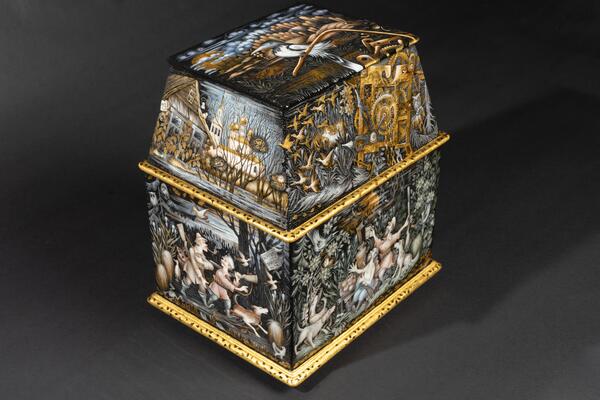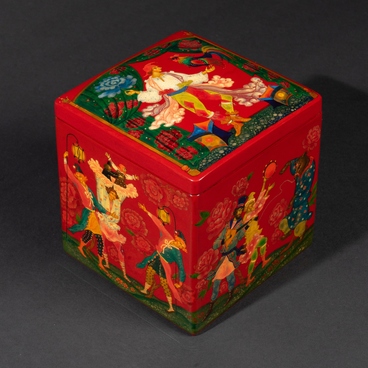The chest ‘The Clock of Time, or the Thieving Magpie’ was created by Kholuy artist Lev Nikonov in 2013. On nine sides of the chest, he painted miniatures illustrating funny anecdotes on the topic of hunting. A thieving magpie constantly interferes with leisure hunting activities: she steals various chains, locks, horseshoes, keys, mechanisms. She throws all this prey into birds’ nests, scatters around the forest and hangs on trees.
The hunters depicted on the chest do not actually hunt: they hang their guns somewhere on their side or sling them over their shoulders. Their dogs are also good-natured: they look at a carrot with much more interest than a bunny caught by the ears. The dogs cheerfully howl to the owners, who sing songs at their tea party with a samovar.
Hunters are accompanied everywhere by curious birds and bubbly frogs. Even ducks play with them rather than act as prey; a sign “Take care of nature” is nailed to a tree and seems to emphasize the general mood of friendliness.
It is important to note that behind the external simplicity of the story lies a serious reflection about the lost time: the thieving magpie personifies the time in life which people steal from themselves. The artist’s message can be interpreted as a warning against spending time in mindless idleness, trashing the world of nature with soulless mechanisms.
Other works of the Kholuy master are also presented in the showcase. The box ‘Under the spring rain’ goes beyond traditional landscape painting. The artist was inspired by Japanese art. He depicted a crowd of people in the form of generalized silhouettes with giant exotic flowers spreading above them. The composition inspires the viewer to a philosophical reflection: when people are in such a hurry, they become insensitive to the cycle of life, and only one person freezes and admires the beauty of the moment.
In his works, the artist actively uses gold, metallic powders and inserts made of mother-of-pearl (a natural material produced by mollusks, internal layer of seashells), which are rarely used in Kholuy art. All these techniques help to create a painting with a magical glow and turn a lacquer box into a precious work of art.
The hunters depicted on the chest do not actually hunt: they hang their guns somewhere on their side or sling them over their shoulders. Their dogs are also good-natured: they look at a carrot with much more interest than a bunny caught by the ears. The dogs cheerfully howl to the owners, who sing songs at their tea party with a samovar.
Hunters are accompanied everywhere by curious birds and bubbly frogs. Even ducks play with them rather than act as prey; a sign “Take care of nature” is nailed to a tree and seems to emphasize the general mood of friendliness.
It is important to note that behind the external simplicity of the story lies a serious reflection about the lost time: the thieving magpie personifies the time in life which people steal from themselves. The artist’s message can be interpreted as a warning against spending time in mindless idleness, trashing the world of nature with soulless mechanisms.
Other works of the Kholuy master are also presented in the showcase. The box ‘Under the spring rain’ goes beyond traditional landscape painting. The artist was inspired by Japanese art. He depicted a crowd of people in the form of generalized silhouettes with giant exotic flowers spreading above them. The composition inspires the viewer to a philosophical reflection: when people are in such a hurry, they become insensitive to the cycle of life, and only one person freezes and admires the beauty of the moment.
In his works, the artist actively uses gold, metallic powders and inserts made of mother-of-pearl (a natural material produced by mollusks, internal layer of seashells), which are rarely used in Kholuy art. All these techniques help to create a painting with a magical glow and turn a lacquer box into a precious work of art.



